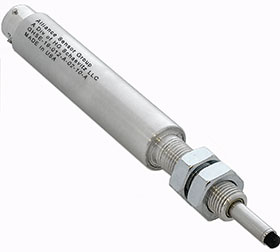

LVITs (linear variable inductive transducers) are relatively low-cost, contactless position sensing devices, which utilise eddy currents induced in the surface of a conductive movable element that is mechanically coupled to the object whose position is being measured. The common form of an LVIT uses a small diameter inductive probe surrounded by a conductive tube called a ‘spoiler’. Modern electronics utilising microprocessors make possible outstanding performance, achieving linearity errors of less than 0,15% of FSO and temperature coefficients of 50 ppm/ºC, along with either analog or digital outputs.
They are used in many factory automation applications, including packaging and material handling equipment, die positioning in plastic moulding machines, roller positioning and web tension controls in paper mills or converting facilities, and robotic spray painting systems. Being contactless, the basic measurement mechanism of an LVIT does not wear out over time due to rapid cycling. LVITs also offer a lower installed cost than that of most other contactless technologies.
Better stroke to length ratios
LVITs can also be spring loaded for use versus other spring-loaded technology solutions such as an LVDT gauge head. In fact, LVITs can be used in place of traditional gauge heads primarily because, electrically, an LVIT offers the same resolution and repeatability and, mechanically, the same outer diameter and an external mounting thread, but with about half of the length of the gauge head, making the stroke to length ratio of an LVIT substantially better. LVIT-based gauging applications in factory automation typically mirror those for traditional gauge heads.
When compared to LVDT pencil gauging probes, a spring-loaded LVIT can satisfy many of the same applications. Pencil probes are typically selected for one of two reasons: resolution and repeatability; or size. Pencil probes are smaller than LVITs, however, a pencil probe requires a separate LVDT signal conditioner, making the cost per channel typically double the cost of an LVIT. If an application does not require the specific features of a pencil probe, a spring-loaded LVIT is a lower cost alternative.
Some factory automation applications traditionally solved by proximity sensors, can be better satisfied with LVIT technology with a proportional analog output, giving greater control flexibility than merely an NPN or PNP TTL switching signal. With an LVIT’s short body length, the sensor can fit in places or mountings where previously a proximity probe was used.
All LVIT products offered by Alliance Sensors Group also feature ASG’s proprietary SenSet field programmable scaling, which allows a user to adjust for any mechanical variations after installation simply by pushing a button or grounding a single connection.
For more information contact John Matlack, Alliance Sensors Group, +1 856 727 0252, [email protected], www.alliancesensors.com

© Technews Publishing (Pty) Ltd | All Rights Reserved